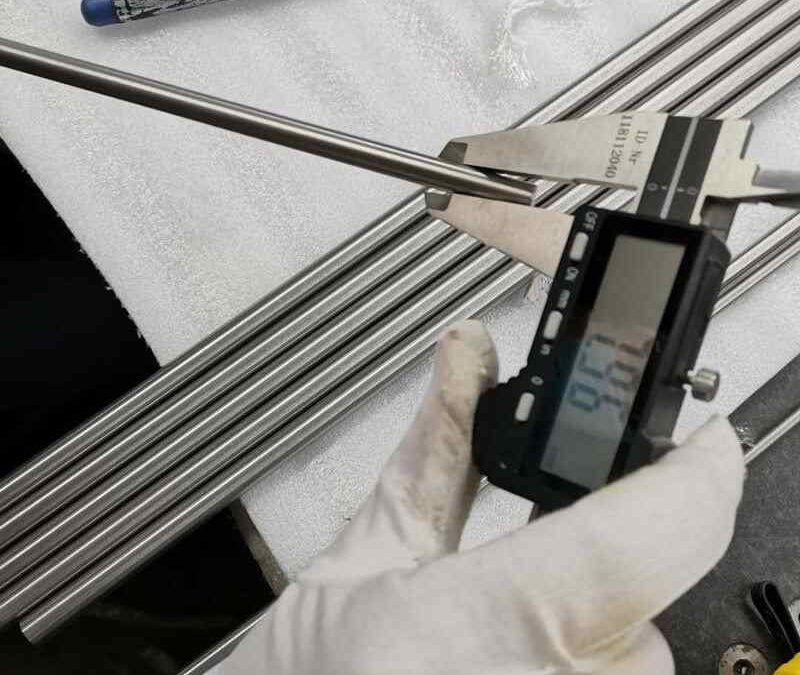Ti6Al4V ELI, also known as Grade 23, is one of the most commonly used titanium alloys is an alpha-beta alloy containing 6% Al and 4% V. This alloy, usually referred to as Ti6Al4V exhibits an excellent combination of corrosion resistance, strength and toughness. Typical uses include medical devices or implants, aerospace applications and pressure vessels. In the case of medical applications, stringent user specifications require controlled microstructures and freedom from melt imperfections. The interstitial elements of iron and oxygen are carefully controlled to improve ductility and fracture toughness. Controlled interstitial element levels are designated ELI (extra low interstitials). Hence the designation Ti6Al4V ELI.
Physical properties
- Melting Range: 2,800-3,000°F (1,538 – 1,649°C)
- Density: 0.160 lbs/cu. in.; 4.47 gm/cc
- Beta Transus Temperature: 1,790°F (± 25°); 976.7°C (± 3.9°)
Hardness
Typical hardness in the annealed condition is Rockwell C 30-34.
Chemistry composition of Ti6Al4V ELI
Element | Content (%) |
|---|---|
| Titanium, Ti | 88.09 - 91 |
| Aluminum, Al | 5.5 - 6.5 |
| Vanadium, V | 3.5 - 4.5 |
| Iron, Fe | ≤ 0.25 |
| Carbon, C | ≤ 0.080 |
| Nitrogen, N | ≤ 0.030 |
| Hydrogen, H | ≤ 0.0125 |
| Other, each | ≤ 0.10 |
| Other, total | ≤ 0.40 |
Machinability of Ti6Al4V ELI
The American Iron and Steel Institute (AISI) determined a rating system of machinability of different materials. 160 Brinell B1112 steel was arbitrarily assigned a machinability rating of 100%. Using this as a comparable standard, ratings less than 100% are more challenging to machine, and ratings more than 100% are easier to machine. Ti6Al4V ELI is rated at 22% of B1112. Low cutting speeds, heavy feed rates, sharp tools, and ample cutting fluid are prescribed.
Surface Conditions
Ti6Al4V ELI has a tendency to stick, fret or cold weld with drawing dies during processing. Common industry practice to avoid this condition usually employs heavy etching or pickling at finish size resulting in a coarse or very textured surface. XOT metals has developed processing techniques with enhanced surface treatments which require minimal etching at finish size to remove residual oxide, yielding a cleaner and smoother surface finish.
Forming
Grade 23 Ti6Al4V ELI alloy can be hot or cold formed. Forming techniques include hydropress, stretch or drop-hammer.
Welding
Weldability of grade 23 Ti6Al4V ELI alloy is rated as fair.
Heat Treatment
The material can be solution treated at 904-954 °C (1660-1750°F) for 2 h, and then water quenched.
Annealing
For annealing grade 23 Ti 6Al-4V ELI alloy, the material has to be held at 732°C (1350°F) for about 1/4 and 4h. It should then be furnace cooled to 566°C (1050°F) then air cooled.
Forging
Rough forging can be performed at 982°C (1800°F), and completed at 968°C (1750°F).
Hot Working
Hot working enhances the overall ductility of the material.
Cold Working
Cold working features of this material is same as that of austenitic stainless steel. Post-work annealing is recommended to re-attain favorable performance properties.
Aging
Aging of grade 23 Ti6Al4V ELI alloy can be performed at 538°C (1000°F) for 4 h and air cooled.
Features
- Resistant to bodily fluids
- Resistant to a variety of corrosive environments
- Freedom from chloride stress corrosion cracking
- Good strength and toughness over a wide temperature range
- High resistance to erosion corrosion and corrosion fatigue
- Useful resistance to dry chlorine, fluorine, hydrogen chloride and hydrogen fluoride gases
Applications
XOT metals manufactures Ti6Al4V ELI in straightened and cut bar, coil, strands and cables, flat wire and wire form to support a variety of critical medical and industrial based applications. End uses include:
- Orthopaedic pins and screws
- Springs
- Orthopaedic cables
- Surgical staples
- Orthodontic appliances
- Ligature clips
For further inormation please write to info@xotmetals.com

